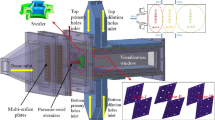Abstract
Research reports indicate that sufficiently high equivalence ratio of the hydrogen/air mixture leads to the upstream burning in the recirculation jacket, possibly damaging the micro- combustor due to the high wall temperature. This work investigates the influences of the equivalence ratio of the mixture on the structure of a micro-combustor device. Numerical simulation approaches focused on the structural design of the micro-combustor with the flame burning in the recirculation jacket. Combustion characteristics of the combustor were first analyzed based on 2D computational Fluid Dynamics (CFD), and then thermo-mechanical analysis on the combustor was carried out by means of 3D Finite Element Analysis (FEA) method. The results showed that the most dangerous locations where the critical failure could possibly occur lay at the burning areas in the recirculation jacket due to the poor bonding, the high temperature and the residual stress. The results of this study can be used for the design and improvement of the micro-combustors.
















Similar content being viewed by others
Abbreviations
- C p :
-
Specific heat (J/kg K)
- EX :
-
Elastic modulus (Pa)
- K :
-
Conductivity (W/m K)
- T:
-
Ambient temperature (K)
- μ :
-
Poisson’s ratio
- ρ :
-
Density (kg/m3)
- σ s :
-
Yield strength (MPa)
- h :
-
Heat transfer coefficient on the outer wall (W/m2 K)
- V :
-
Mass flow rate of the mixture (g/s)
- ε :
-
Radiation emissivity of silicon
- δ :
-
Equivalence ratios of the hydrogen/air mixture
- α :
-
Coefficient of thermal expansion of silicon
References
Bagdahn J, Sharpe WN Jr (2003) Fracture strength of polysilicon at stress concentrations. IEEE J Microelectromech Syst 12:302–312
Chen KS (1999) Materials characterization and structural design of ceramic micro turbomachinery. Ph.D. thesis, Massachusetts Institute of Technology, Cambridge, MA
Chen KS, Ayon AA, Zhang X (2002) Effect of process parameters on the surface morphology and mechanical performance of silicon structures after deep reactive ion etching. IEEE J Microelectromech Syst 11:264–275
Epstein AH (2003) Millimeter-scale, MEMS gas turbine engines. In: Proceedings of ASME Turbo Expo 2003 Power for Land, Sea, and Air (2003), vol 6, pp 16–19
Hua J, Wu M, Kumar K (2005a) Numerical simulation of the combustion of hydrogen–air mixture in micro-scaled chambers Part II: CFD analysis for a micro-combustor. Chem Eng Sci 60:3507–3515
Hua J, Wu M, Kumar K (2005b) Numerical simulation of the combustion of hydrogen–air mixture in micro-scaled chambers Part I: fundamental study. Chem Eng Sci 60:3497–3506
Klaasen EH, Petersen K, Noworolskil JM (1996) Silicon fusion bonding and deep reactive ion etching: a new technology for microstructures. Sens Actuators A 52:132–139
Mehra A (2000) Development of a high power density combustion system for a silicon micro gas turbine engine, Ph.D. thesis, Massachusetts Institute of Technology, Cambridge, MA
Mehra A, Waitz IA (1998) Development of a hydrogen combustor for a microfabricated gas turbine engine. In: Solid state sensor and actuator workshop 1998, pp 224–231
Mehra A, Ayón AA, Waitz IA, Schmidt MA (1999) Microfabrication of high temperature silicon devices using wafer bonding and deep reactive ion etching. IEEE J Microelectromech Syst 8:152–160
Miki N, Zhang X (2003) Multi-stack silicon-direct wafer bonding for 3D MEMS manufacturing. Sens Actuators A 103:194–201
Park JH, Choi HC (2005) FEM analysis of multilayered MEMS device under thermal and residual stress. J Microsyst Technol 11:925–933
Spadaccini CM (2004) Combustion systems for power-MEMS applications. Ph.D. thesis, Massachusetts Institute of Technology, Cambridge, MA
Spadaccini CM, Jin L, Zhang X (2003) High power density silicon combustion system for micro gas turbine engines. J Eng Gas Turbines Power 125:709–719
Zhang X, Chen KS (2002) Residual stress and fracture of thick dielectric films for power MEMS applications. IEEE J Microelectromech Syst 11:164–167
Zhang X, Ghodssi R, Chen KS (2000) Residual stress characterization of thick PECVD TEOS film for power MEMS applications. In: Solid state sensor and actuator workshop 2000, pp 316–319
Acknowledgments
Dr. Lin Zhu would like to thank the financial support for the project from the Chinese National Foundation (50721140651), Anhui Province National Foundation (KJ2009B004Z), and Anhui Agricultural University Applied Research Grant (wd2008-6). Dr. Tien-Chien Jen would also like to acknowledge the partial financial support from EPA (RD833357) and Research Growth Initiative II from University of Wisconsin, Milwaukee.
Author information
Authors and Affiliations
Corresponding author
Rights and permissions
About this article
Cite this article
Zhu, L., Jen, TC., Ji, YF. et al. Numerical investigation of the structure of a silicon six-wafer micro-combustor under the effect of hydrogen/air ratio. Microsyst Technol 16, 1777–1786 (2010). https://doi.org/10.1007/s00542-010-1116-7
Received:
Accepted:
Published:
Issue Date:
DOI: https://doi.org/10.1007/s00542-010-1116-7




